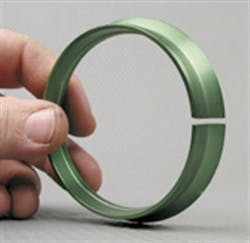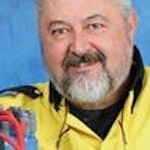To prevent comebacks and complaints about vibration problems that won´t show up even when you re-balance, make sure that the wheel is properly centered onto the hub to achieve concentric operation.
In other words, the center of the wheel must align with the center of the hub so that the tire rolls down the road without excessive radial runout.
One of two methods are used to properly center the wheel: hubcentric locating and lugcentric locating. Hubcentric means that the wheel relies on its centering at the hub, while lugcentric wheels rely on fastener alignment alone.
If the wheel is centered using a hubcentric approach, the true centering of the wheel to the hub/axle centerline is handled by the fit of the wheel´s center hole female rear face over a male shoulder that surrounds the hub center.
If the wheel is centered using a lugcentric method, wheel centering position is determined by matching the wheel holes relative to the wheel studs. This assumes that the wheel´s fastener holes will precisely locate over the studs, when clamped with nuts, to align the wheel center to the hub axle center.
How can you identify the type of centering method? If the rear of the wheel features a distinct female recess that fits snugly over the hub´s raised (male) center flange, the wheel is hubcentric. If the rear of the wheel´s center hole does not feature a machined recess, or if the hub face does not feature a raised male lip surrounding its center, the wheel is lugcentric.
[PAGEBREAK]
INSTALLATION
When installing hubcentric wheels, the wheel must be fully seated so that the center female relief engages over the hub´s male locating lip. Always make sure you follow the correct tightening sequence.
When installing a lugcentric wheel, it´s very important to avoid allowing the wheel to simply "hang" on the studs while installing the nuts. Hold the wheel flat to the hub face, and gradually snug the nuts, again following the correct tightening sequence (apply even clamping pressure across the wheel´s bolt pattern).
If the wheel´s bolt holes are somewhat forgiving (larger than necessary), it´s possible to tighten the wheel slightly off-center. This will result in easy threading of some nuts, while others may require additional force because they are experiencing too much sidewall friction on one side of the hole.
Lugcentric wheels, by virtue of relying on proper (and equal) centering of each wheel bolt hole over each hub stud, are extremely susceptible to off-centering if the wheel´s bolt holes are damaged (elongated) through abuse. Wheel bolt-hole damage is cause for concern on any wheel, but can result in wheel centering problems and subsequent radial runout on a lugcentric style attachment.
Hubcentric wheels are less prone to be affected, since centering relies on the wheel center-to-hub-center mating.
OE VS. AFTERMARKET
Hubcentric wheels may be designed as vehicle-specific. This means that the female recess on the rear of the wheel´s center hole may be machined to precisely fit over the hub´s male centering lip.
However, many aftermarket custom wheels may be designed to fit a number of different vehicle applications, in order to reduce SKUs. In this case, the wheel´s female recess may be maximized to fit the largest diameter hub center.
In order to fit the same wheel onto vehicles that feature smaller diameter hub centers, alloy or plastic hubcentric spacers are necessary. The spacer´s OD (outside diameter) is designed to fit the wheel´s large recess, and the spacer´s ID (inside diameter) is sized to fit specific smaller hub center flanges.
A variety of spacers are available with ID dimensions to fit the hub lip OD of all vehicles intended for that specific wheel. These spacers simply snap into the rear of the wheel´s center recess, and are held captive to the wheel. These spacers usually are designed to prevent sticking (via electrolysis) to the wheel or hub (plastic spacers or anodized alloy).
If the set of wheels you ordered for a specific vehicle are designed for hubcentric centering, don´t blindly assume that you can simply bolt the wheels on and go. Pay attention to the fit of the wheel´s rear center recess to the hub male center flange. If it does not fit snugly (far too loose), hubcentric spacers may be needed.
Usually, aftermarket wheels are shipped with spacers when needed to suit the particular vehicle. Always check with your supplier to determine if spacers are needed for a specific vehicle application.
LOOK FOR SPACERS
Whenever an alloy wheel is removed, remember to look for spacers. If the wheels are hubcentric, and spacers were in place, the spacer may be stuck to the wheel, or it may stick to the hub, or it may fall to the floor unnoticed. If the same wheel is reinstalled without a spacer, there may be a radial runout condition.
If the original wheel used a spacer, and that spacer stuck to the hub, this might be not readily noticed. If a custom wheel is then installed with a new spacer, the old spacer will be trapped at the hub (with two spacers now being stacked), and the wheel will not fully seat against the hub face. When the nuts or bolts are tightened, the wheel will be distorted because it´s not flat against the hub face. Always make a point to examine the wheel and the hub for signs of adapter spacers.
Give hubcentric wheels lip service
The need to keep hub faces (and the rear wheel face) clean and free of contaminants is critical with any wheel installation, whether lugcentric or hubcentric. However, on a hubcentric style, added attention is required to ensure that the hub´s male centering lip is clean and free of burrs, rust scale, excess paint buildup, etc.
Examine the hub face and be sure to clean the centering lip flange, paying particular attention to the outer walls of the male lip and the transition corner where the male lip meets the flat hub face. Use a wire brush to clean this area.




